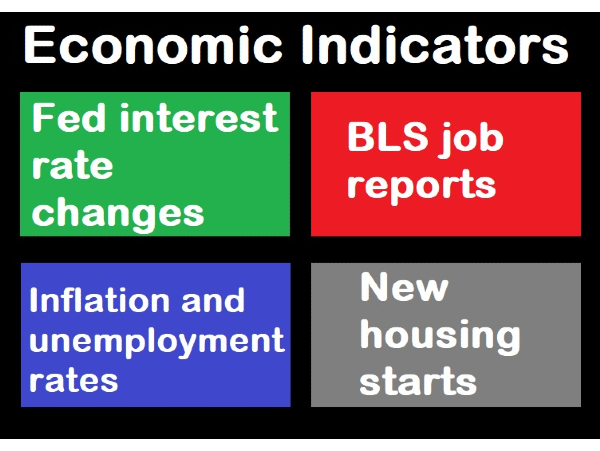You know that investing in the stock market is the only way to grow your nest egg (wealth). You also know which industries are more recession-proof than others. In the long run, you know that a diversified portfolio of blue chip stocks always gets gains.
In the short run, however, it can also be helpful to know what might signal to the stock market and lead to a selloff (fall in share prices) or a buying frenzy (rise in share prices). Investors take their cues on current and future economic and market conditions from government reports and actions. If these reports and actions signal future growth, demand for shares increases. However, if these reports and actions signal a slowdown in growth, it can spook investors into selling.
First, investors look at the monthly jobs report coming from the Bureau of Labor Statistics (BLS). These releases are usually breaking news, as they are major indicators of economic health. The number of jobs added per month sends a signal of business confidence, as businesses will hire fewer workers if they predict rough economic times ahead.
If the number of added jobs is under 200,000, it's bad news! The U.S., due to population growth, must add at least this many jobs per month to avoid an increase in the unemployment rate. A weak jobs report is bad, and an official increase in the unemployment rate is worse. Investors, fearing a recession, will begin to sell their stocks, sending prices down. While this is not a signal for you to sell, it may be a sign that you should switch your new monthly purchases of stocks toward recession-proof industries
Second, and more important, investors look at news coming from the Federal Reserve System, known as "the Fed." The Fed conducts monetary policy in the United States by influencing interest rates. When the economy is in a recession and the Fed wants to increase spending, it lowers interest rates. When there is too much inflation, however, the Fed wants to reduce spending and will raise interest rates. This is what the Fed has done this week, and is why the stock market is facing a selloff.
When the Fed raises interest rates, it signals rough times for businesses. Normally, businesses borrow money to expand their operations. When interest rates rise, businesses are less likely to borrow money. This reduces investor confidence and can lead to a bear market. Even if other economic indicators are healthy, Fed interest rate hikes are the most powerful influence on business investment (borrowing money to expand operations and/or buy equipment). This is why the markets are sinking despite a strong jobs report.
Third, investors look at housing starts. This is a longer-term indicator of economic health and consumer confidence, as houses can take up to a year to build. The number of new houses started signals the confidence of home builders in the strength of the market and consumer income. A significant increase in new house starts signals that there is belief that consumers will have strong incomes up to one year from now.
However, this indicator can be countered by interest rates, as interest rates are a primary determinant in monthly mortgage prices. When interest rates rise, consumers have less demand to take out a mortgage. If interest rates rise too much, new housing starts will fall as home builders fear a reduced demand for mortgages.
Investors need to look for news on economic indicators to determine whether they should be buying more recession-proof stocks. Higher interest rates can reduce spending and push an economy into a recession, which can be made worse by weak job additions to the economy and a reduction in housing starts. Knowledge is power, and investors who know which way the economy is likely to move first will be able to get the best deals on buying and selling stocks.!















You know that investing in the stock market is the only way to grow your nest egg (wealth). You also know which industries are more recession-proof than others. In the long run, you know that a diversified portfolio of blue chip stocks always gets gains.
In the short run, however, it can also be helpful to know what might signal to the stock market and lead to a selloff (fall in share prices) or a buying frenzy (rise in share prices). Investors take their cues on current and future economic and market conditions from government reports and actions. If these reports and actions signal future growth, demand for shares increases. However, if these reports and actions signal a slowdown in growth, it can spook investors into selling.
First, investors look at the monthly jobs report coming from the Bureau of Labor Statistics (BLS). These releases are usually breaking news, as they are major indicators of economic health. The number of jobs added per month sends a signal of business confidence, as businesses will hire fewer workers if they predict rough economic times ahead.
If the number of added jobs is under 200,000, it's bad news! The U.S., due to population growth, must add at least this many jobs per month to avoid an increase in the unemployment rate. A weak jobs report is bad, and an official increase in the unemployment rate is worse. Investors, fearing a recession, will begin to sell their stocks, sending prices down. While this is not a signal for you to sell, it may be a sign that you should switch your new monthly purchases of stocks toward recession-proof industries
Second, and more important, investors look at news coming from the Federal Reserve System, known as "the Fed." The Fed conducts monetary policy in the United States by influencing interest rates. When the economy is in a recession and the Fed wants to increase spending, it lowers interest rates. When there is too much inflation, however, the Fed wants to reduce spending and will raise interest rates. This is what the Fed has done this week, and is why the stock market is facing a selloff.
When the Fed raises interest rates, it signals rough times for businesses. Normally, businesses borrow money to expand their operations. When interest rates rise, businesses are less likely to borrow money. This reduces investor confidence and can lead to a bear market. Even if other economic indicators are healthy, Fed interest rate hikes are the most powerful influence on business investment (borrowing money to expand operations and/or buy equipment). This is why the markets are sinking despite a strong jobs report.
Third, investors look at housing starts. This is a longer-term indicator of economic health and consumer confidence, as houses can take up to a year to build. The number of new houses started signals the confidence of home builders in the strength of the market and consumer income. A significant increase in new house starts signals that there is belief that consumers will have strong incomes up to one year from now.
However, this indicator can be countered by interest rates, as interest rates are a primary determinant in monthly mortgage prices. When interest rates rise, consumers have less demand to take out a mortgage. If interest rates rise too much, new housing starts will fall as home builders fear a reduced demand for mortgages.
Investors need to look for news on economic indicators to determine whether they should be buying more recession-proof stocks. Higher interest rates can reduce spending and push an economy into a recession, which can be made worse by weak job additions to the economy and a reduction in housing starts. Knowledge is power, and investors who know which way the economy is likely to move first will be able to get the best deals on buying and selling stocks.!